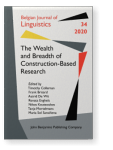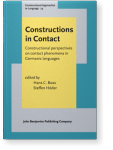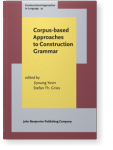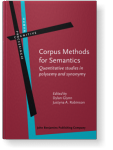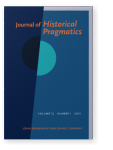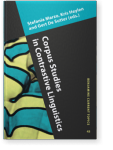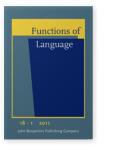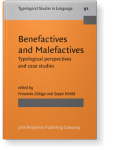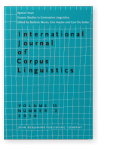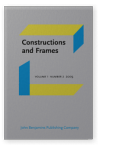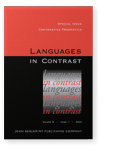Timothy Colleman
List of John Benjamins publications for which Timothy Colleman plays a role.
Journal
ISSN 2950-189X | E-ISSN 2950-1881
Yearbook
Book series
Titles
Ditransitives in Germanic Languages: Synchronic and diachronic aspects
Edited by Eva Zehentner, Melanie Röthlisberger and Timothy Colleman
[Studies in Germanic Linguistics, 7] 2023. vi, 446 pp.
Subjects Germanic linguistics | Syntax | Theoretical linguistics
The Wealth and Breadth of Construction-Based Research
Edited by Timothy Colleman, Frank Brisard, Astrid De Wit, Renata Enghels, Nikos Koutsoukos, Tanja Mortelmans and María Sol Sansiñena
[Belgian Journal of Linguistics, 34] 2020. vii, 382 pp.
Subjects Theoretical linguistics
2023 Looking back and looking forward: The Belgian Journal of Linguistics (1986–2023) Belgian Journal of Linguistics, Volume 37 (2023): Tangible Traces of Language Ideologies, Baiwir, Esther, Janine Berns and Marie Steffens (eds.), pp. 1–5 | Editorial
2023 Ditransitive constructions in Germanic languages: New avenues and new challenges Ditransitives in Germanic Languages: Synchronic and diachronic aspects, Zehentner, Eva, Melanie Röthlisberger and Timothy Colleman (eds.), pp. 1–18 | Chapter
2020 Introduction: The wealth and breadth of construction-based research The Wealth and Breadth of Construction-Based Research, Colleman, Timothy, Frank Brisard, Astrid De Wit, Renata Enghels, Nikos Koutsoukos, Tanja Mortelmans and María Sol Sansiñena (eds.), pp. 1–4 | Introduction
2018 Distributional assimilation in constructional semantics: On contact-related semantic shifts in Afrikaans three-argument constructions Constructions in Contact: Constructional perspectives on contact phenomena in Germanic languages, Boas, Hans C. and Steffen Höder (eds.), pp. 143–177 | Chapter
This paper brings a contact linguistic perspective to the investigation of variation and change in the semantic structures of schematic argument structure constructions, i.e. diachronic constructional semasiology. The empirical focus is on three clusters of ongoing change in the lexical and… read more
2016 Sense-based and lexeme-based alternation biases in the Dutch dative alternation Corpus-based Approaches to Construction Grammar, Yoon, Jiyoung and Stefan Th. Gries (eds.), pp. 165–198 | Article
In semantic studies of argument structure alternations as well as in psycholinguistic
studies on syntactic priming, lexical alternation biases are typically measured
at the level of the verb lexeme. This study explores the hypothesis that the
proper locus of subcategorization probabilities is the… read more
2016 A reflection on constructionalization and constructional borrowing, inspired by an emerging Dutch replica of the ‘time’-away construction Computational Construction Grammar and Constructional Change, Beuls, Katrien and Remi van Trijp (eds.), pp. 91–113 | Article
While recent years have seen an increased interest for the potential effects of language contact on the formal and/or semantic properties of constructions, existing case studies of (potentially) contact-induced change in individual constructions (e.g. Pietsch 2010; Höder 2012, 2014; Van de Velde… read more
2016 Tracking shifts in the literal versus the intensifying fake reflexive resultative construction: The development of intensifying dood ‘dead’ in 19th–20th Century Dutch Computational Construction Grammar and Constructional Change, Beuls, Katrien and Remi van Trijp (eds.), pp. 55–90 | Article
This paper explores diachronic shifts in the literal and intensifying uses of dood ‘dead’ in the Dutch fake reflexive resultative construction. Without sufficient context, a clause like Hij werkte zich dood (lit. ‘He worked himself dead’) is ambiguous in that it is unclear whether dood expresses… read more
2015 Constructionalization and post-constructionalization: The constructional semantics of the Dutch krijgen-passive from a diachronic perspective Diachronic Construction Grammar, Barðdal, Jóhanna, Elena Smirnova, Lotte Sommerer and Spike Gildea (eds.), pp. 213–256 | Article
The grammatical literature on Dutch generally distinguishes two “passive” alternatives to the active double object construction, one of which, the so-called krijgen-passive is a fairly recent addition to the grammar, the earliest reported examples dating from around 1900. The present chapter… read more
2014 Tracing the history of deontic NCI patterns in Dutch: A case of polysemy copying Diachronic Corpus Pragmatics, Taavitsainen, Irma, Andreas H. Jucker and Jukka Tuominen (eds.), pp. 213–236 | Article
While the so-called “nominative-and-infinitive” (NCI) is no longer a productive construction in Dutch, the grammar of Present-day Dutch still contains a small set of lexically substantive NCI patterns, most notably geacht worden te and verondersteld worden te. Like their English formal equivalent… read more
2014 Competing ‘transfer’ constructions in Dutch: The case of ont-verbs Corpus Methods for Semantics: Quantitative studies in polysemy and synonymy, Glynn, Dylan and Justyna A. Robinson (eds.), pp. 39–60 | Article
This paper zooms in on the semantic relations between the constructions of
“possessional transfer” (i.e. constructions used to encode events of possessional
transfer) in Dutch by zooming in on a specific morphological class of dispossession
verbs, viz. verbs with the prefix ont- ‘away’, such as… read more
2012 The Dutch evidential NCI: A case of constructional attrition Journal of Historical Pragmatics 13:1, pp. 1–28 | Article
Present-day Dutch has two entrenched “grammatical” hearsay evidentials: a construction with zou (originally the past tense form of the verb zullen, cognate with German sollen) and a construction with schijnen (literally, ‘seem’). The closest English equivalent of both constructions is the… read more
2012 Believe-type raising-to-object and raising-to-subject verbs in English and Dutch: A contrastive investigation in diachronic construction grammar Corpus Studies in Contrastive Linguistics, Marzo, Stefania, Kris Heylen and Gert de Sutter (eds.), pp. 7–32 | Article
The so-called ‘raising-to-subject’ pattern that verbs of the type believe can occur in is usually treated as the passive alternative for the so-called ‘raising-to-object’ pattern. In addition to broadening the empirical basis for the opposite claim that the English and Dutch raising-to-subject (or… read more
2011 The syntactic flexibility of (new) verbs of instrument of communication: A corpus-based study Functions of Language 18:1, pp. 57–86 | Article
In this paper, the structural possibilities of well-established ‘verbs of instruments of communication’ (Levin 1993) such as telephone, fax and telegraph are compared with the syntactic possibilities of recent newcomers to the field such as skype and blackberry. The analysis, which is based on… read more
2011 The nominative and infinitive in English and Dutch: An exercise in contrastive diachronic construction grammar Contrastive Pragmatics, Aijmer, Karin (ed.), pp. 143–180 | Article
The nominative and infinitive (or NCI) is a syntactic pattern that has so far not been given its due in the linguistics of languages that possess structures that could go by that name. In English and Dutch these were probably introduced (or at the very least revived) into the grammar as loans from… read more
2010 The benefactive semantic potential of ‘caused reception’ constructions: A case study of English, German, French, and Dutch Benefactives and Malefactives: Typological perspectives and case studies, Zúñiga, Fernando and Seppo Kittilä (eds.), pp. 219–244 | Article
English, German, French and Dutch all exhibit a ditransitive construction in which the verb is combined with a subject and two NP objects (either unmarked or with overt dative and/or accusative case), which typically encode the agent, theme and recipient of a ‘caused reception‘ event. In… read more
2010 Believe-type raising-to-object and raising-to-subject verbs in English and Dutch: A contrastive investigation in diachronic construction grammar Corpus Studies in Contrastive Linguistics, Marzo, Stefania, Kris Heylen and Gert de Sutter (eds.), pp. 157–182 | Article
The so-called ‘raising-to-subject’ pattern that verbs of the type believe can occur in is usually treated as the passive alternative for the so-called ‘raising-to-object’ pattern. In addition to broadening the empirical basis for the opposite claim that the English and Dutch raising-to-subject (or… read more
2009 The semantic range of the Dutch double object construction: A collostructional perspective Constructions and Frames 1:2, pp. 190–220 | Article
Just like its English counterpart (cf. Goldberg 1995), the Dutch double object construction is a prime example of a highly polysemous argument structure construction, with a basic ‘X causes Y to receive Z’ sense and several extended meanings which depart from the prototype in various respects and… read more
2009 The nominative and infinitive in English and Dutch: An exercise in contrastive diachronic construction grammar Contrastive Pragmatics, Aijmer, Karin (ed.), pp. 144–181 | Article
The nominative and infinitive (or NCI) is a syntactic pattern that has so far not been given its due in the linguistics of languages that possess structures that could go by that name. In English and Dutch these were probably introduced (or at the very least revived) into the grammar as loans from… read more
2008 Accounting for ditransitive constructions with envy and forgive Functions of Language 15:2, pp. 187–215 | Article
This paper presents an in-depth analysis of the English verbs envy and forgive in the ditransitive argument structure pattern [Sbj V Obj Obj]. Since the ditransitive construction is often associated with a basic ‘transfer of possession’ meaning in existing analyses of its constructional semantics,… read more



